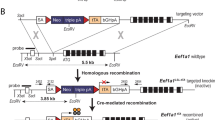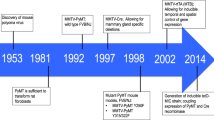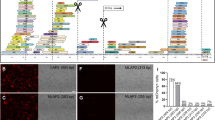Abstract
The whey acidic protein (WAP) promoter is known to be active in pregnant and lactating mammary epithelial cells as well as mammary tumors of mice. Here we show that a proximal fragment of the murine WAP promoter, including most elements postulated as being responsible for mammary-specific regulation, confers mammary-specific expression upon a marker gene in transgenic mice even though the distal promoter region, known to be important for rat WAP promoter activity, is lacking. The relatively small size of this fragment allows its insertion into a murine leukemia virus–based retroviral vector in place of the viral promoter. Infection of a number of established human mammary and nonmammary cell lines with such a retroviral vector revealed that the WAP promoter was limited in its activity to mammary tumor cell lines. Expression in tumorigenic mammary cells was even more pronounced when these cells were introduced into the mammary fat pads of mice. This is the first demonstration that the WAP promoter is active in human mammary cells and mammary tumor cells in general, and suggests that the extended proximal WAP promoter may be useful for directing therapeutic gene expression to human mammary tumors.
This is a preview of subscription content, access via your institution
Access options
Subscribe to this journal
Receive 12 print issues and online access
$259.00 per year
only $21.58 per issue
Buy this article
- Purchase on Springer Link
- Instant access to full article PDF
Prices may be subject to local taxes which are calculated during checkout





Similar content being viewed by others
References
Salmons B, Gunzburg WH . Targeting of retroviral vectors for gene therapy Hum Gene Ther 1993 4: 129–141
Weber E, Anderson WF, Kasahara N . Recent advances in retrovirus vector-mediated gene therapy: teaching an old vector new tricks Curr Opin Mol Ther 2001 3: 439–453
Hennighausen L . The mammary gland as a bioreactor: production of foreign proteins in milk Protein Expression Purif 1990 1: 3–8
Hennighausen LG, Sippel AE, Hobbs AA, Rosen JM . Comparative sequence analysis of the mRNAs coding for mouse and rat whey protein Nucleic Acids Res 1982 10: 3733–3744
Devinoy E, Hubert C, Schaerer E, Houdebine L-M, Kraehenbuhl J-P . Sequence of the rabbit whey acidic protein cDNA Nucleic Acids Res 1988 16: 8180
Simpson KJ, Bird P, Shaw D, Nicholas K . Molecular characterisation and hormone-dependent expression of the porcine whey acidic protein gene J Mol Endocrinol 1998 20: 27–35
Ranganathan S, Simpson KJ, Shaw DC, Nicholas KR . The whey acidic protein family: a new signature motif and three-dimensional structure by comparative modeling J Mol Graphics Model 1999 17: 106–113
Li S, Rosen JM . Nuclear factor I and mammary gland factor (STAT5) play a critical role in regulating rat whey acidic protein gene expression in transgenic mice Mol Cell Biol 1995 15: 2063–2070
Liu X, Robinson GW, Gouilleux F, Groner B, Hennighausen L . Cloning and expression of Stat5 and an additional homologue (Stat5b) involved in prolactin signal transduction in mouse mammary tissue Proc Natl Acad Sci USA 1995 92: 8831–8835
Gronostajski RM . Roles of the NFI/CTF gene family in transcription and development Gene 2000 249: 31–45
Li S, Rosen JM . Distal regulatory elements required for rat whey acidic protein gene expression in transgenic mice J Biol Chem 1994 269: 14235–14243
Stocklin E, Wissler M, Gouilleux F, Groner B . Functional interactions between Stat5 and the glucocorticoid receptor Nature 1996 383: 726–728
Cella N, Groner B, Hynes NE . Characterization of Stat5a and Stat5b homodimers and heterodimers and their association with the glucocorticoid receptor in mammary cells Mol Cell Biol 1998 18: 1783–1792
Gunzburg WH, Salmons B, Zimmermann B, Mueller M, Erfle V, Brem G . A mammary-specific promoter directs expression of growth hormone not only to the mammary gland, but also to Bergmann glia cells in transgenic mice Mol Endocrinol 1991 5: 123–133
Lubon H, Hennighausen L . Conserved region of the rat alpha-lactalbumin promoter is a target site for protein binding in vitro Biochem J 1988 256: 391–396
Mink S, Haertig E, Jennewein P, Doppler W, Cato ACB . A mammary cell specific enhancer in mouse mammary tumor virus DNA is composed of multiple regulatory elements including binding sites for CTF/NFI and a novel transcription factor, mammary cell–activating factor Mol Cell Biol 1992 12: 4906–4918
Welte T, Garimoth K, Philipp S et al. Involvement of Ets-related proteins in hormone-independent mammary cell–specific gene expression Eur J Biochem 1994 223: 997–1006
McKnight RA, Spencer M, Dittmer J, Brady JN, Wall RJ, Hennighausen L . An ets site in the whey acidic protein promoter mediates transcriptional activation in the mammary gland of pregnant mice but is dispensable during lactation Mol Endocrinol 1995 9: 717–724
Rosen JM, Zahnow C, Kazansky A, Raught B . Composite response elements mediate hormonal and developmental regulation of milk protein gene expression Biochem Soc Symp 1998 63: 101–113
Mrochen S, Klein D, Salmons B, Nikol S, Smith JR, Gunzburg WH . Inducible expression of p21WAF-1/CIP-1/SDI-1 from a promoter-conversion retroviral vector J Mol Med 1997 75: 820–828
Saller RM, Özturk F, Salmons B, Günzburg WH . Construction and characterization of a hybrid mouse mammary tumor virus/murine leukemia virus–based retroviral vector J Virol 1998 72: 1699–1703
Kolb AF, Gunzburg WH, Albang R, Brem G, Erfle V, Salmons B . A negative regulatory element in the mammary specific whey acidic protein promoter J Cell Biochem 1994 55: 245–261
Kolb AF, Albang R, Brem G, Erfle V, Gunzburg WH, Salmons B . Characterization of a protein that binds a negative regulatory element in the mammary-specific whey acidic protein promoter Biochem Biophys Res Commun 1995 217: 1045–1052
Brem G . Transgene Nutztiere Zuchtungskunde 1998 60: 248–262
Klein D, Bugl B, Günzburg WH, Salmons B . Accurate estimation of transduction efficiency necessitates a multiplex real-time PCR Gene Ther 2000 7: 458–463
Price J, Turner D, Cepko C . Lineage analysis in the vertebrate nervous system by retrovirus-mediated gene transfer Proc Natl Acad Sci USA 1987 84: 156–160
Saller RM . Design von locus-und gewebespezifische retroviralen Vektoren für eine in vivo Gentherapie Munich: Biology Faculty, Ludwig-Maximillian University 1994
Jainchill JL, Anderson SA, Todaro GJ . Murine sarcoma and leukemia viruses: assay using clonal lines of contact-inhibited mouse cells J Virol 1969 4: 549–553
Miller AD, Buttimore C . Redesign of retrovirus packaging cell lines to avoid recombination leading to helper virus production Mol Cell Biol 1986 6: 2895–2902
Crandell RA, Fabricant CG, Nelson-Rees WA . Development, characterization, and virus susceptibility of a feline (Felis catus) renal cell line (CRFK) In Vitro 1973 9: 176–185
Parada LF, Tabin CJ, Shih C, Weinberg RA . Human EJ bladder carcinoma oncogene is homologue of Harvey sarcoma virus ras gene Nature 1982 297: 474–478
Lieber M, Mazzetta J, Nelson-Rees W, Kaplan M, Todaro G . Establishment of a continuous tumor-cell line (PANC1) from a human carcinoma of the exocrine pancreas Int J Cancer 1975 15: 741–747
Ringold G, Lasfargues EY, Bishop JM, Varmus HE . Production of mouse mammary tumor virus by cultured cells in the absence and presence of hormones: assay by molecular hybridization Virology 1975 65: 135–147
Engel WL, Young NA, Tralka TS, Lippman ME, O'Brien SJ, Joyce MJ . Establishment and characterization of three new continuous cell lines derived from human breast carcinomas Cancer Res 1978 38: 3352–3364
Keydar I, Chen L, Karby S et al. Establishment and characterization of a cell line of human breast carcinoma origin Eur J Cancer 1979 15: 659–670
Soule HD, Vazquez J, Long A, Albert S, Brennan M . A human cell line from a pleural effusion derived from a breast carcinoma J Natl Cancer Inst 1973 51: 1409–1416
Hornsby PJ, Salmons B . Oncogene expressing cell lines Cell and Tissue Culture: Laboratory Procedures Chichester, West Sussex: Wiley 1994 26D: 2.1–2.5
Maniatis T, Fritsch EF, Sambrook J . Extraction, Purification and Analysis of mRNA from Eukaryotic Cells Cold Spring Harbor, NY: Cold Spring Harbor Laboratory 1982
Jain V, Magrath I . A chemiluminescent assay for quantitation of beta-galactosidase in the femtogram range: application to quantitation of beta-galactosidase in lacZ transfected cells Anal Biochem 1991 199: 119–124
Miller AD, Rosman GJ . Improved retroviral vectors for gene transfer and expression Biotechniques 1989 7: 980–990
Klein D, Indraccolo S, von Rombs K, Amadori A, Salmons B, Günzburg WH . Rapid identification of viable retrovirus transduced cells using the green fluorescent protein as a marker Gene Ther 1997 4: 1256–1260
Goff SP . Genetics of retroviral integration Annu Rev Genet 1992 26: 527–544
Roskelley CD, Srebow A, Bissell MJ . A hierarchy of ECM-mediated signalling regulates tissue-specific gene expression Curr Opin Cell Biol 1995 7: 736–747
Yarus S, Rosen JM, Cole AM, Diamond G . Production of active bovine tracheal antimicrobial peptide in milk of transgenic mice Proc Natl Acad Sci USA 1996 93: 14118–14121
Brandazza A, Lee E, Ferrera M, Tillman U, Sarmientos P, Westphal H . Use of the urokinase-type plasminogen activator gene as a general tool to monitor expression in transgenic animals: study of the tissue-specificity of the murine whey acidic protein (WAP) expression signals J Biotechnol 1991 20: 201–212
Devinoy E, Thépot D, Stinnakre M-G et al. High level production of human growth hormone in the milk of transgenic mice: the upstream region of the rabbit whey acidic protein (WAP) gene targets transgene expression to the mammary gland Transgenic Res 1994 3: 79–89
Wen J, Kawamata Y, Tojo H, Tankaka S, Tachi C . Expression of whey acidic protein (WAP) genes in tissues other than the mammary gland in normal and transgenic mice expressing mWAP/hGH fusion gene Mol Reprod Dev 1995 41: 399–406
Miller DG, Adam MA, Miller AD . Gene transfer by retrovirus vectors occurs only in cells that are actively replicating at the time of infection Mol Cell Biol 1990 10: 4139–4242
Kammertöns T, Gelbmann W, Karle P et al. Combined chemotherapy of murine mammary tumors by local activation of the prodrugs ifosfamide and 5-fluorocytosine Cancer Gene Ther 2000 7: 629–636
Acknowledgements
We thank David Winder and Robert Saller for helpful advice. This project was financed, in part, by a grant from the Bavarian Forschungsstiftung FORGEN 2 programme.
Author information
Authors and Affiliations
Corresponding author
Rights and permissions
About this article
Cite this article
Öztürk-Winder, F., Renner, M., Klein, D. et al. The murine whey acidic protein promoter directs expression to human mammary tumors after retroviral transduction. Cancer Gene Ther 9, 421–431 (2002). https://doi.org/10.1038/sj.cgt.7700456
Received:
Published:
Issue Date:
DOI: https://doi.org/10.1038/sj.cgt.7700456



